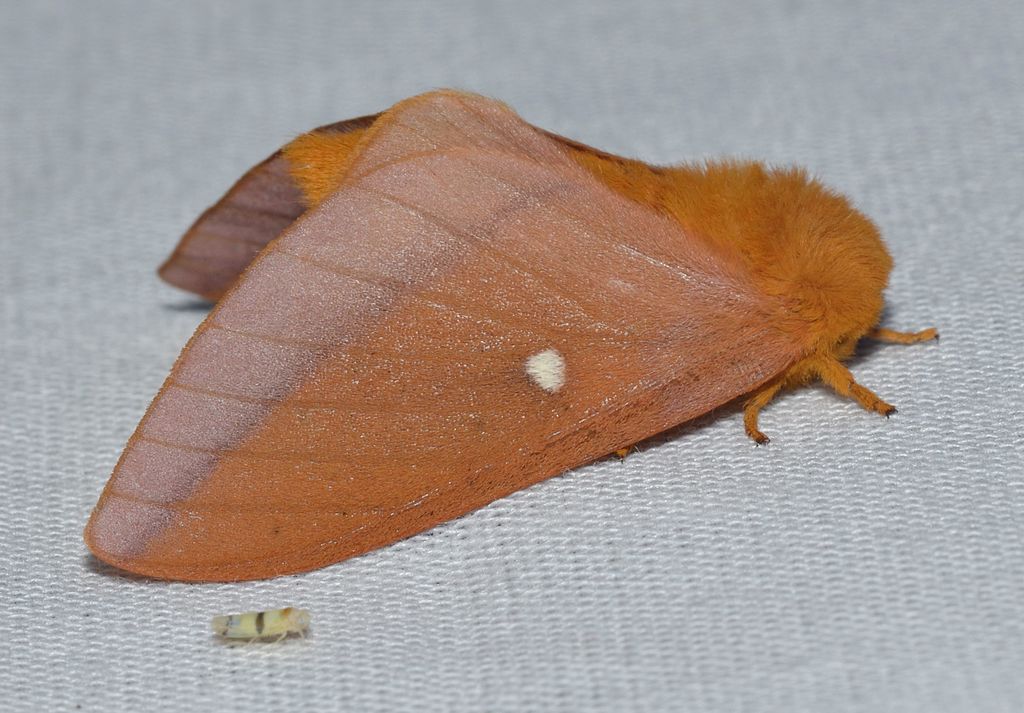Introduction
Pink-striped oakworm moth (Anisota virginiensis) is a species of silk moth in the family Saturniidae. It is notable for the distinct coloration of the adults. The larvae are ravenous feeders. They feast on the branches of host plants, partially defoliating them. When populations are dense, outbreaks can occur. During outbreaks, trees that are weakened or diseased may be further destabilized.
Distribution & Habitat
In Canada, pink-striped oakworm moth has a range extending from Nova Scotia to southeastern Manitoba. In the United States, the insect has been reported from the Great Lakes to New England, and south to the Gulf Coast region, northern Florida, and east Texas. It is most commonly found in deciduous woodlands, suburbs, parks, and landscapes.
Hosts
Pink-striped oakworm moth generally infests oaks. Birches, maples, and hazel trees are also infested, albeit with less frequency.
Description
The eggs produced by the adults are greenish-yellow, and spherically shaped. The larvae are gray, green, or tan with dull brown, yellow, or light pink stripes. The insect’s head is larger than the rest of the body. A pair of black, fleshy filaments protrude outwards from just behind the head. The abdomen is covered in scales. The inside of the mouth is yellow. Each leg is partially translucent. The pupa are dark brown.
The adult females are larger than the males. The female’s body is covered in a bevy of fine, bright orange to yellow hair-like structures. The wings are covered in thin scales, and are nearly transparent. A thick band of pink or dull purple is apparent at the wing margins. The male’s torso is a purple-brown color. The hindwing is splotched with red. Both genders feature a characteristic white cell spot in the center of the forewing. When at rest, the wings are held flat across the insect’s back. The insect’s wing span measures between 4.2 and 6.6 cm. The previously fleshy filaments become broad and feathered.
Life Cycle
Pink-striped oakworm moth produces one generation in the northern part of its range, and two generations in the south. Before completing its life cycle, the insect progresses through four stages: an egg stage, a larval stage, a pupal stage, and an adult stage. The adults emerge from their pupal caverns from late June to early July. The females emit a pheremone that attracts the males. Once the males have located the females, they mate. Mating typically occurs during the morning. Upon fertilization, the females navigate to host trees, and deposit clusters of eggs on the underside of leaves.
The eggs hatch 1 to 2 weeks later, revealing masses of larvae. The larvae congregate on leaves, and feed on plant foliage together. As the larvae mature, they begin to separate from their groups, and feed independently. From August to September, the larvae rapidly grow, molting several times before reaching maturity. Upon maturation, the larvae descend to the ground, and penetrate a few inches into the soil. Once in the soil, the larvae construct tiny burrows, which they pupate in. The larvae overwinter in the burrows, and appear as adults the following summer, beginning the cycle anew.
Symptoms of Infestation
The larvae are voracious feeders. Large populations can severely defoliate infested oak trees. However, because the larvae feed during fall, most trees will have already begun to enter dormancy. As such, defoliation will have a limited effect on healthy trees. Trees that are already in a weakened state when infested may decline more. Consecutive defoliations can render the tree more susceptible to disease pathogens and insect infestations.
Late-instar larvae will excrete copious amounts of frass. The frass can collect on sidewalks, furniture, and buildings, reducing the aesthetic quality of the environment. The larvae will often wander on sidewalks, furniture, and buildings while searching for plant foliage to consume.
Management
- The adult stage of pink-striped oakworm moth does not feast on plant foliage. As such, treatment for the insect is seldom required.
- Maintain tree vigor through sound cultural practices.
- Ensure that trees are sufficiently watered, especially during extended periods of drought.
- Apply a layer of organic mulch around the base of vulnerable trees to improve the soil quality, moderate the soil temperature, and retain soil moisture.
- Prune out dead or dying branches from trees.
- Avoid mechanical injuries to the bark of trees.
- Leaves that are laden with eggs may be removed from the tree, and disposed of.
- Pink-striped oakworm moth has a bevy of natural predators and parasitoids that help to limit its populations.
- Trees can be sprayed in late summer or fall with the biological pesticide, Bacillus thuringiensis. Applications should be administered 1 to 2 weeks after the eggs have hatched, when the larvae are still developing.
- Insecticides registered for use on pink-striped oakworm moth are effective at controlling the insect. However, this method may also harm any beneficial insects that are present in the environment.
Photo courtesy of Andy Reago & Chrissy McClarren CC-by-2.0
